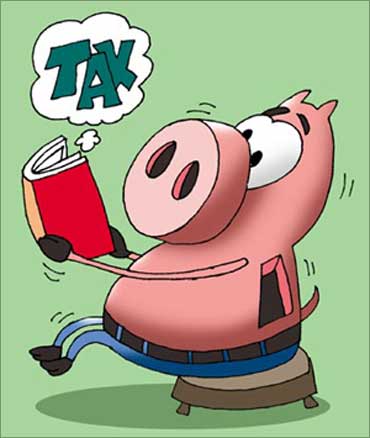Photographs: Uttam Ghosh/Rediff.com Sunil Dhawan, Outlook Money
Prosperity, especially when it carries an undertone of excesses, is a relatively new concept for the salaried class in India.
Two decades or so ago, it meant a comfortable life at best. But times have changed and so have the fortunes of the salaried class, which has gone from strength to strength in the last few years.
However, the fact remains that a salaried person has to meet his and his family's present and future needs with the cheque that he gets at the end of the month.
If he is not fully aware of tax rules and smart ways to bring his tax liability down, his goals could be in jeopardy.
Here we look at how salaried people should go about tax planning.
. . .
Salaried? Here's how to save on TAX
Planning it right
The major breaks for the salaried come under Section 80C of the Income Tax Act. You can get tax benefits by investing in specified financial products, up to an aggregate of Rs 1 lakh (Rs 100,000).
While tax breaks are undoubtedly important, you must remember that there is a larger purpose to investing in a financial instrument.
Let us look at how one should invest in tax-saving instruments without compromising on the fulfilment of long-term goals.
Existing outflows
Find out your existing commitments under Section 80C investments.
Usually, insurance renewal premiums, children's tuition fees, the principal portion of your home loan EMI, and contribution to the EPF, add up to a sizeable amount of the Rs 1 lakh limit.
. . .
Salaried? Here's how to save on TAX
Link to your goals
Always choose a tax-saver by linking it to a long-term goal. That's because most tax-saving instruments are long-term in nature and that's how they work best. Never invest with the sole objective of saving taxes.
Post-tax returns
Consider, for example, investments in National Savings Certificate (NSC) that give you Section 80C benefits but returns from which (8 per cent per annum) are taxable.
The effective post-tax return works out to be 5.53 per cent for people in the highest tax bracket. Your candy isn't as big as you thought!
Bunching of expenses
Planning in advance helps you avoid bunching of too many expenses in a particular month.
Or, it could happen that your investment in a tax-saving product coincides with hefty premiums for insurance policies, and you fall short of funds to meet an important household expense next month. Try spreading your outflows across the year.
. . .
Salaried? Here's how to save on TAX
Frequency of payments
In most fixed income tax-savers, it can be annual, except for Public Provident Fund (PPF).
In market-linked tax savers, such as equity-linked saving schemes (ELSS) and unit-linked insurance plans (Ulips), even monthly payments can be beneficial as they help in cost-averaging.
In traditional life insurance products, however, annual payments are better as they are subsidised compared to monthly or half-yearly payments.
Choice of products
The mix of products should be such that funds are allocated to both equity and debt assets, keeping your age, responsibilities and future goals in mind.
. . .
Salaried? Here's how to save on TAX
The kick-off (age 20-30)
Rarely do people worry about saving for the future at this age. The irony is, any savings made at this stage give you a big headstart.
Earmark funds from your salary and start systematic investment plans (SIPs) in 2-3 ELSS that have performed consistently for long.
Remember, each SIP would have a lock-in of three years. If you are not short on funds, it's better to make lump sum investments.
Instead of keeping funds in a savings account, which gives low returns, keep accumulating money in a liquid fund or a recurring deposit, and then make a lump sum investment in an ELSS.
These schemes do not just help you save taxes, but with their three-year lock-in, make sure that you can't exit the scheme and redeem your funds.
You may choose to continue with your investment after the completion of the lock-in period.
Except for the mandatory contribution through Employees' Provident Fund (EPF), not much 'saving activity' happens during early years.
. . .
Salaried? Here's how to save on TAX
Remember, EPF is a fixed-income debt product. The current interest rate is 9.5 per cent per annum and tax deduction is available on employee's contribution.
Though it remains largely hidden in one's portfolio, EPF is the highest tax-free fixed income returns generator. Even though you are allowed to increase your EPF contribution to up to 100 per cent of your basic salary, tax benefit is only till the mandatory limit of 12 per cent of salary.
Increase the contribution only if you are comfortable doing so. Upon switching jobs, keep shifting the account to the new employer as interest is not paid on a dormant account (more than three years without contribution).
Contributions towards EPF are not part of your take-home pay. Hence, allocate a portion of your net income towards other debt assets as well. PPF is an ideal choice.
Given its safety (it's backed by the government), relatively high returns (currently 8 per cent per annum) and tax exemptions on interest earnings and the final corpus, the effective post-tax return currently works out to more than 11 per cent per annum.
The minimum investment you need to make in a PPF account every year is Rs 500. With one contribution allowed a month, you can even invest small amounts for your long-term goals.
If you wish to invest a large amount, say, the maximum of Rs 70,000 per year, it's better to contribute towards PPF at the beginning of each month as interest is credited on the balance between 1st and 5th of each month.
. . .
Salaried? Here's how to save on TAX
Family affairs (age 30-40)
The ideal time to buy a life insurance cover is when you have family members who are financially dependent on you.
This is best met through a pure term plan. It is a low-premium, high-cover term insurance plan that comes with tax benefits.
Get a life cover of at least 10 times your annual income. Keep reviewing it at major developments, such as at the birth of a child or while taking a home loan.
Online term plans are cheaper, so you could consider them. For a high coverage amount, say Rs 1 crore (Rs 10 million), go for two policies with varying term periods. Drop one as liabilities taper off in the later stages of life.
Once ready with your strongest line of defence in the form of term insurance, continue with your PPF and ELSS investments.
It makes sense to exhaust the Rs 70,000 limit for PPF by both husband and wife if both of them are taxpayers. Earmark the funds in the PPF account for your kid.
. . .
Salaried? Here's how to save on TAX
Remember, however, that the PPF accounts of a parent and a minor child taken together cannot exceed deposits of Rs 70,000 in a year.
Similarly, investments in ELSS may be nominated separately in each child's name. This keeps your investments focused on a specific goal.
Two other important outflows also qualify for tax deduction. One, the principal repayment of a home loan, if it has been taken from any housing finance institution and, two, tuition fees for kids.
If, after totalling your PF contributions, term plan premiums, ELSS savings and kids' tuition fees, you are short of the Rs 1-lakh mark, increase your allocation to ELSS.
For risk-averse taxpayers, options include notified bank fixed deposits or NSC, among others. Once Section 80C is exhausted, you may consider investments in Section 80 CCF (infrastructure bonds).
As you near retirement, fresh tax-saving instruments need to be carefully selected, based on the holding period.
Keep the maturity period well within your retirement date. Investments in ELSS schemes may slowly be shifted to debt assets.
. . .
Salaried? Here's how to save on TAX
Tax savers and using them optimally
Employee Provident Fund
- Avoid withdrawals
- Keep transferring EPF to new employer
- Raise contribution up to 100 per cent of salary if convenient
Term insurance plan
- Opt for online plans
- Get cover at least 10 times your annual income
- Choose plans that give cover till maximum age and have maximum term
- Split term policies if sum assured is high
Equity-linked savings scheme (ELSS)
- 3-year lock-in. Stay invested even afterwards if returns are good.
- Choose not more than 2-3 funds from OLM 50
- Opt for lump sum investment instead of SIP
Public Provident Fund
- Rs 70,000 limit per year for parent and minor child's account together. Maximise contribution.
- Avoid withdrawals. Extend after completion of lock-in (15 years), if need be.
. . .
Salaried? Here's how to save on TAX
Conclusion
The final choice of an instrument should ideally be based on a gamut of factors rather than solely be driven by the returns from it.
There is no such instrument that can help you save taxes and, at the same time, provide safe, assured and high returns.
The effort should be to build up a portfolio that can deliver decent returns at a low level of risk.












article